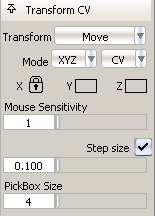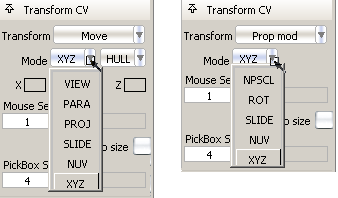
Transforms CVs and hulls subject to different constraints.
When you click the Transform CV  icon at the bottom of the Control Panel, the following options appear.
icon at the bottom of the Control Panel, the following options appear.

These options let you move CVs and hulls relative to their curve or surface, in the view plane, along a given vector or reference plane, or in the X, Y, or Z direction. They also let you rotate or scale CVs and hulls with respect to a pivot point, and also move that pivot point.
Finally, they let you move, rotate, or scale CVs by different amounts depending on their proximity to a primary (or master) CV.
Move – This tool lets you move CVs relative to their curve or surface, along a given vector or reference plane, in the plane of the current view, or in the X, Y, or Z direction.
Rotate – This tool behaves like the Transform tool of the same name, rotating CVs around the object’s rotation pivot point.
Scale – This tool behaves like the Transform tool of the same name, scaling CVs proportionally along all 3 axes, with respect to the object’s scaling pivot point.
Non-p scale – This tool behaves like the Transform tool of the same name, scaling CVs by different amounts along each axis, with respect to the object’s scaling pivot point.
Pivot – This tool behaves like the Transform tool of the same name, positioning the object’s pivot points. It uses the options from Set Pivot to determine which pivot(s) to move (Rotation, Scaling, or both).
Prop mod – This tool behaves in a way similar way to Transform > Modify > Proportional mod but its interface is more intuitive and easily allows experimentation with falloff values.
The left mode menu appears only if Transform is set to Move or Prop mod.

The left mode menu controls the action and the right mode menu controls the objects (CVs or Hulls) that the action affects.
XYZ – This mode moves CVs along the X, Y, Z world axes. The mouse buttons operate the same as in the Transform > Move (or Transform > Modify > Proportional mod) tool.
SLIDE – This mode moves CVs along their respective hull. For Prop mod, the arrows only appear around the primary CV.
NUV – This mode moves CVs along the normal, or in the U or V direction on a surface, using the left, middle and right mouse buttons respectively.
The following three modes apply only to Move transformations.
PROJ – This mode moves CVs in the direction of a hull line, a vector, or constrains the movement to a reference plane.
PARA – This mode moves CVs parallel to a vector or hull line without snapping to it.
VIEW – This mode moves CVs in the plane of the current view.
 = Unconstrained movement in the current plane defined by the direction of the view.
= Unconstrained movement in the current plane defined by the direction of the view.
 = Movement constrained to the horizontal axis of the screen.
= Movement constrained to the horizontal axis of the screen.
 = Movement constrained to the vertical axis of the screen.
= Movement constrained to the vertical axis of the screen.
The following two modes apply only to Prop mod transformations.
ROT – This mode rotates CVs relative to their proximity to a center "master" CV.
NPSCL – This mode non-proportionally scales CVs relative to their proximity to a center "master" CV.
Click the right menu to select CV or HULL. The right mode menu controls the object that the action affects and the left mode menu controls the action.
This menu does not appear when Transform is set to Prop mod since this tool only affects CVs.
CV – Lets you select and move individual CVs. Hold down the  key to select more than one CV while within the tool.
key to select more than one CV while within the tool.
HULL – Lets you select a hull line as a way of selecting and moving all CVs on that hull line at once. You can still add other
hull lines to your selection by holding down the  key.
key.
This slider controls the effect that dragging the mouse has on CV movement.
The slider values range from 1 to 100 (but values larger than 100 can be typed in the number field). This number represents the ratio between the distance the cursor moves and the distance the CV moves, on the screen. Hence, the default of 1 means that a CV moves the same distance as the mouse cursor. A value of 2 means that the CV moves half the distance of the cursor, and so on. The higher the sensitivity value, the smaller the effect that the mouse movement has on the CV.
Check this box if you want to move the CV in increments of a given size, for example 10.0 units. Enter the step size value in the text field.
When clicking and releasing the mouse in a given location, the CV jumps by the chosen step size (in linear units) in the direction of the mouse click. The step size is also applied when using the arrow keys, but not when dragging the mouse (see Mouse Sensitivity above).
This slider increases the size of the selection area, making CVs easier to pick. The drawing of the cursor remains unchanged.
The default size is 4, meaning a pick box that is 4 pixels wide by 4 pixels high, centered on the CV. Clicking anywhere within this box selects the CV. Pick box size can be increased up to a value of 32 pixels.
When the Transform CV tool is selected, holding down the space bar displays the Hot Spot interface under the cursor. Using this interface instead of accessing the options in the Control Panel reduces mouse movement when doing direct surface manipulation.

The transform tools are available in the horizontal ribbon, and the different modes that apply to the selected tool are displayed on the wheel. The center spot is divided into two halves: CV and Hull. Roll-over an icon to see a description of what it does.
How to use the Hot Spot interface
 tool in the Control Panel.
tool in the Control Panel.